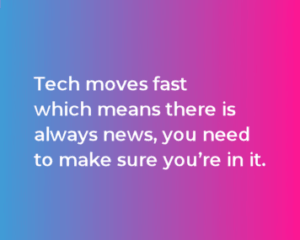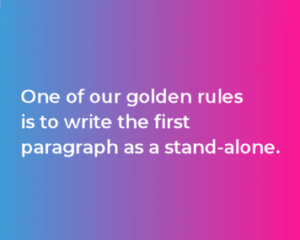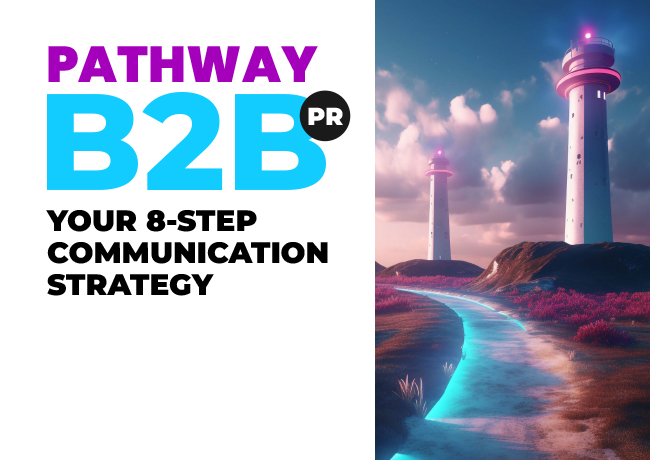
How to write a tech news release in 2021
10 questions to consider when writing a tech news release
 There are ten key questions you should consider when you start planning a tech news release. The purpose of a news release is to communicate to your target audiences that you are an active player in the market and worth talking to; it’s also a valuable vehicle to remind your competition that you’re a force to be reckoned with. Tech moves fast which means there is always news, so you need to make sure you are part of it. So, here’s a checklist to ensure focused and impactful B2B tech news delivery.
There are ten key questions you should consider when you start planning a tech news release. The purpose of a news release is to communicate to your target audiences that you are an active player in the market and worth talking to; it’s also a valuable vehicle to remind your competition that you’re a force to be reckoned with. Tech moves fast which means there is always news, so you need to make sure you are part of it. So, here’s a checklist to ensure focused and impactful B2B tech news delivery.
1 Ask yourself, what is the news story? (in less than 20 words)
A news story is something that has never been announced before – it’s important to remember this. It is bad practice to dress up an old event and try and pass it off as a news story. So, ask yourself: what is the new and interesting element of my news story? If you can answer this, you will know whether you have the power to excite your audience or not. The story is not the product or service, it is what the product or service will do for the industry.
2 Is a news release the right vehicle?
It is easy to believe that a new customer, new product, or a new office is all news, and that a news release is the only vehicle. But might a 1000-word article placed in your top target media outlet be a better way of communicating your messages than a short news mention? The article can be shared widely on LinkedIn, re-purposed for a blog, and may have a far more powerful outcome for the brand. Consider all options before just defaulting to a news release.
3 What is your ‘headline grabber’?
You want to grab the journalist’s attention straight away, so you need a headline that is arresting, demands attention and makes the reader want to read on. In B2B, a news release announces one of the following recent achievements: a client/customer contract win, a significant technological development, or a new industry insight – possibly because of recent research. Caution: unless your most recent recruit is a well-recognised industry authority, new employee announcements are best done through internal comms. It’s not news.
‘Business benefits’ is a much-overused phrase in tech PR but, being honest, whatever your news is, it must connect with the industry, as making money is a driving factor, for you and your customers. You need to write a headline which will not only engage the journalist but will attract the audience of your chosen target media.
4 Does every word pack a punch?
The first paragraph should fully encapsulate the core message with every word packing a punch. One of our golden rules is to write the first paragraph as a stand-alone. In years gone by, this meant that if an editor was short of space, they could edit from the bottom up. If all that was left was the first paragraph, this should stand alone as a summary of the story. Of course, the advent of online media means that space isn’t necessarily an issue for editors now, but don’t think this means you can ramble on forever. Editors may not be short of space, but readers are definitely short on time.

Now, having identified the story and written your release, you can write your headline. Headlines should be factual and arresting, signposting what the story is about, and be mindful to avoid technical jargon.
5 What language should you use?
Keep your language business like and easy to understand. The days of ‘waffle’ and jargon are over. Be succinct, factual, using British English, and ensure every word in the first paragraph supports the exact story you are delivering. Less is definitely more.
6 Who is the audience for your news release?
While drafting, keep in mind the audience for your news release, specifically the readers of the publications you are targeting. Again, much over-emphasised, but if you are launching an education technology story, make sure your language reflects the academic industry and that it will resonate with readers.
And then, once drafted, some final words of advice:
7 Have you sense-checked your news release?
Just because you know your subject matter does not necessarily mean your news release will make sense to the reader. Once the release is written, give yourself a break, do something else before reading it a couple more times. Keep asking if you’ve made clear compelling points. Reading out loud can provide an effective reality check and it’s sensible to ask a colleague who doesn’t work in your team to review the text. If at this stage, it doesn’t deliver, you will know before it hits the editors’ inboxes, and you have time to re-word to shape up your copy.
8 Can a news release be too short?
If you miss out evidence or fail to give the necessary context, a news release can become too brief – in which case, the editorial team may reject it because it appears insubstantial or that it simply doesn’t fit their format. A press release should be at least 450 words, traditionally, no longer than 1.5 sides of A4, using 1.5 spacing. If you need to go beyond this with supporting documents, include links. It will be easier for the journalist to publish, and you’ll be keeping it lean and focused.
9 Are backlinks in news releases a good idea?
A backlink should be considered an essential element of your news release – it’s not a good idea, it’s a brilliant one! Nothing should go to the media these days without at least one backlink to the company website, possibly a second link to a specific landing page which is relevant to the product/service/report you are launching. This will send readers straight to your target webpage. By using trackable links, you are also providing yourself with a key measurement tool. Some media will have a policy of no links, but it’s always worth a try.
10 How do you distribute a news release?
You should never distribute a news release without considering the inbox of the recipients. Always send a news release to named journalists at your target publications. Ideally, someone who has expressed an interest in your type of technology or service. The days of blasting out a release were over well before the COVID-19 pandemic, and these days it is harder to connect with media, since phone follow-ups are a no-no. A succinct email pitch, followed by the release, to a target journalist, is what is required. Make it brief, targeted and friendly, and never add attachments, but rather links to images using Dropbox or a similar cloud platform.
Need help writing your tech news release?
For help writing and distributing tech news releases for your B2B business reach out to our specialists today. Or take a look at the PRCA website for their “Writing Effective Press Releases” course. And if you would like to learn more about writing for your target audience, we’d highly recommend this valuable guide: the 8-step communication strategy.
Or, if you’d just like to stay in touch – sign up here to receive regular insights on how to make your PR work harder.

DOWNLOAD: Your 8-Step Communication Strategy
A complete guide to delivering your business plan

Your 8-Step Communication Strategy Guide
A comprehensive guide to delivering your business goals using intelligent and relevant messaging.
Subscribe to our updates
Stay up to date with the latest insights, case studies, and PR guides.

